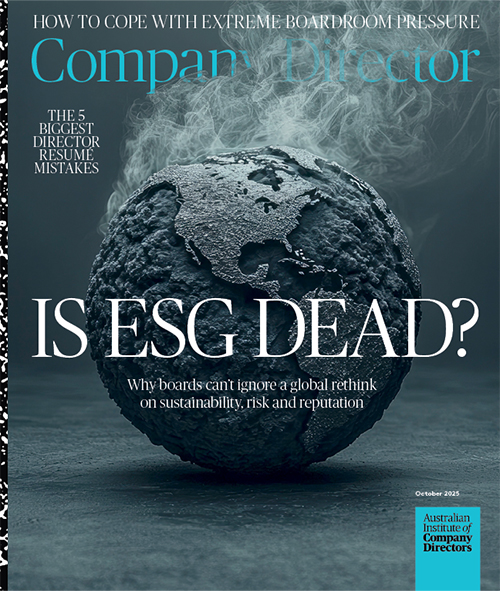Michael Chaney FAICD, who has chaired Wesfarmers for more than a decade, joined REA Group’s Owen Wilson FAICD in an AICD webinar to reflect on culture, succession and the discipline of knowing when to hand over the reins.
Leadership advice lands differently when offered by those who are preparing to leave.
During a recent AICD webinar on the board’s role in executive success, Michael Chaney FAICD and Owen Wilson FAICD shared their perspectives on succession, culture and the chair–CEO relationship. Chaney, who has led Wesfarmers’ board for more than 10 years, and Wilson, stepping down as REA Group’s CEO after six, have both announced their departures, with successors already in place.
Chaney explained his decision to step down with dry humour. “I’ll be 76 next year and I thought, well, I could carry on, but I don’t want to get to a point where I can’t remember where the boardroom is.”
Wilson framed his own exit around timing: “The business was at the top of its game. The way I’m wired, if there was a burning platform, there’s no way I could step away.”
The conversation, supported by new BoardOutlook data on board–executive dynamics, is an interesting study in long-term thinking, cultural stewardship and the partnership required for sustainable success. Access the webinar recording here.
Purpose and performance
For Chaney, long-term returns and good corporate citizenship are inseparable. Reflecting on Wesfarmers’ approach, he said: “As a listed company, we’re not interested in being the biggest X or Y in any particular industry. We’re interested in providing shareholder returns.”
He pushed back on claims boards are overly concentrating on ESG at the expense of performance. “There’s been external commentary over the last year or two about boards focusing too much on ESG or diversity and inclusion and so on and not enough on shareholder returns. I think that’s completely ridiculous.”
Referring to Wesfarmers, he added: “We’ve never seen any conflict between being a good corporate citizen and providing good shareholder returns because they go hand in hand. Unless you’re looking after your employees, paying your suppliers on time, giving your customers the products they want at the right price, looking after the environment, supporting the communities in which you operate, you’re never going to achieve good shareholder returns.”
Wilson reinforced the point with process. At REA, culture is measured and monitored continuously, he said. “We do annual engagement surveys, quarterly values reporting and then monthly pulse checks. We use that to find any areas where it’s drifting, where there might be specific problems.”
Chaney added that the real test comes when issues arise. Boards must respond “appropriately, expeditiously” – signalling that culture is taken seriously.
The tyranny of the quarter
BoardOutlook’s Sarah Graff observed that directors remain confident about short-term delivery but less certain about preparedness for the decade ahead. “Directors have identified major project execution, long-term strategic thinking and talent development as priority areas,” she said.
Both Wesfarmers and REA have resisted the pressure of providing profit guidance.
“We don’t provide any guidance at Wesfarmers. We’ve never provided any profit guidance because we’ve always felt that it just makes it harder – you’re on the hook as far as market expectations go,” Chaney said. “I’ve always felt that under promising and over delivering is a much better strategy, even if it disappoints in the short term.”
Wilson agreed: “We don’t give profit guidance either. We’ll talk about yield, but that’s about it.”
Execution and discipline
For Chaney, execution excellence rests on preparation and vigilance – building in contingency and conducting sensitivity analysis and responding early to fix issues. “When the project’s up and running, if you’re departing from the S-curve, you know why and how you might restore yourself and the business back to the S-curve.”
Wilson stressed early board involvement, especially where stakeholder interests diverge. “We take new projects, new products to the board incredibly early. We start to get feedback from day one, and that’s been really helpful, particularly when it’s been a controversial type of product.”
He recalled instances where management enthusiasm has met board resistance - “products that management were very excited about [such as] new ways of monetising our data. And the board has simply said, ‘No’”.
Similar caution shaped REA’s entry into financial services. “It’s fair to say the board’s risk appetite for this was lower than management’s. They responded by asking us to slow down, to trial things, to do them in small increments so that we could learn and fail fast. As it turned out, it’s been a huge success,” said Wilson.
Succession and communication
Both leaders argued that succession must be systematic and constant. REA ranks talent as either ready now, ready in one to two years, or ready in three to five years, extending beyond executive ranks. “We are seeking people in the organisation who, with the right development, could be sitting around the executive table. We want to identify those people and make sure we develop them appropriately.”
Wesfarmers supplements formal planning with informal access. “We do look in detail at what plans there are for developing people and filling gaps and promoting people and so on. At a board level we also have regular fireside chats. We’ve now expanded that to make sure we get to know the next level down a bit better.”
Regular communication underpins both partnerships. Chaney and Wesfarmers CEO Rob Scott talk weekly, often daily. “It’s really critical. Rob travels a lot and I travel a fair bit, but we religiously have a time each week where we talk. Some weeks we’re interacting every day. We schedule a regular catch-up so that I know what’s on his mind, he knows what’s on mine. And when I’m in the office, we sit and chew the fat.”
Wilson urged boards and executives to keep channels open. “I would speak to my chair almost daily, even for two or three minutes. But I’ve encouraged every other board member to reach out, and often board members would rather raise something with you in private.”
The discipline of leaving
Graff asked whether boards have the courage to prioritise the long term, even when it means enduring short-term pain in front of shareholders. For Chaney and Wilson, courage also means choosing the right time to go.
Chaney has announced his handover to former BHP Chair Ken MacKenzie, with 15 months of transition. He joked: “By the way, I said to the board, I’m going to count the number of times that people say to me in the next year, ‘I thought you retired’.”
For Wilson it is about life and opportunity: “My kids are all adults now. I was starting to get approached about some other things outside REA that were looking interesting. It felt like a good time to pass the baton to someone else.”
Different timing, same principle: leadership is not just about holding on, but about knowing when to step back.
Latest news
Already a member?
Login to view this content



